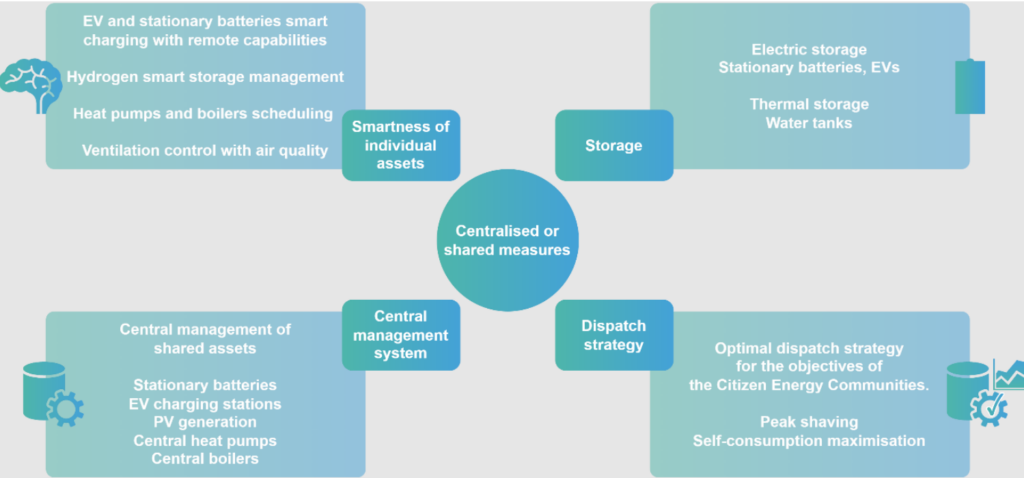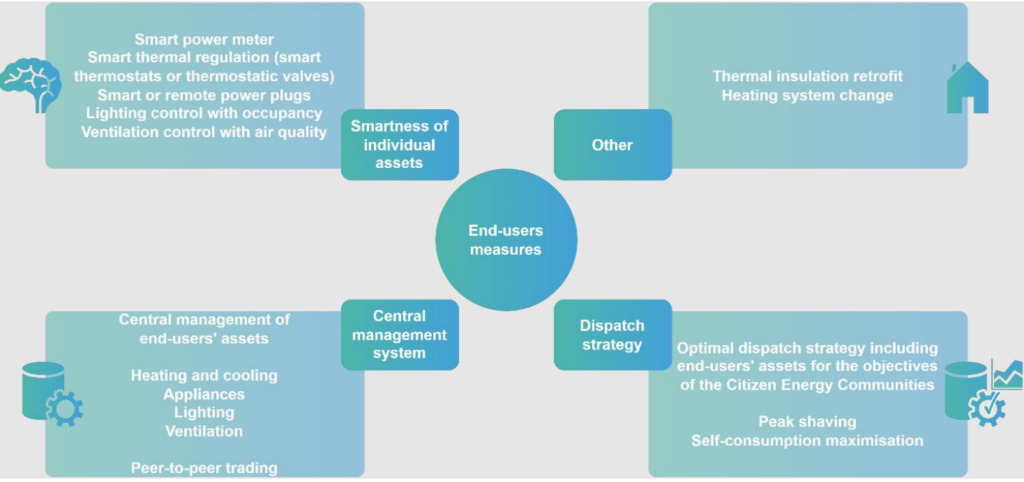NEON aims to improve the quality and life of European communities through the incorporation of next-generation integrated energy services. These services would unlock the potential of building energy efficiency, renewable energy sources and storage, and flexibility services. Successful integration depends on creating strong synergies between grid stakeholders, services providers, and consumers through cross-sector agreements.
Multi-measure energy efficiency interventions
A multitude of opportunities, with a focus on ‘smartness
Following the goals of NEON, we are exploring and evaluating a wide range of multi-measure energy efficiency interventions with four Citizen Energy Communities. Identifying the most valuable building retrofit and cross-services integration opportunities are critical to developing an effective strategy.
These measures address building system efficiency, energy supply and storage, and the ‘smartness’ of the site. Improving and upgrading the ‘smartness’ of the site is essential to implementing advanced control strategies. On the one hand, monitoring energy flows improves energy management, and is essential for the implementation of automation measures. On the other hand, automation systems control the dispatch of energy or the load while ensuring the consumers’ comfort.
Plan of interventions
A multi-level implementation with numerous technical approaches
As the name implies, multi-measure interventions include solutions at different levels and aspects, in this case, promoting energy efficiency.
The interventions differ in their technical aspect:
- ‘Smartness’ of individual assets: there are self-contained solutions on the market that can provide ‘smartness’ to different technologies. They enable data collection and remote-control functions. They improve the individual consumption of the asset, while facilitating its future integration into a centralized management system.
- Storage: adding electric or thermal storage capacity increases the flexibility potential of the system. It helps maximize self-consumption of local solar production.
- Centralized management system: with the right hardware and communication infrastructure, monitoring, visualization or dispatching assets can be managed centrally. This measure requires that the assets have data acquisition and remote-control capabilities.
- Dispatch strategy: once the assets are centralized, a customized dispatch strategy can be
developed to achieve the CECs’ objectives, such as peak shaving or self-consumption
maximization. It requires the estimation of consumption and flexibility potential to optimize overall energy management and interaction with the grid.
The proposed measures also differ in their degree of implementation:
- Centralized or shared assets: the measures at the shared asset level allow for centralized implementation, which benefits all stakeholders and limits privacy issues. Because they tend to involve heavier assets, they generally have the greatest impact and savings.

- End-user assets: decentralized actions, at the end-user level, require more effort to implement. They require user buy-in and active participation, in addition to the necessary hardware. Therefore, it is important to create the right incentives and remuneration schemes to encourage these measures. In addition, when consumers are involved in a centralized management system, a secure communication infrastructure is required to ensure their privacy.

Key outcomes
A gradual strategy for strong CECs and optimal energy management
The impact of the proposed actions will be assessed through with two indicators:
- The GoFlex indicator evaluates the flexibility potential of a building. It is characterized in part by the class of the management system, which ranges from D to A depending on 16 predefined requirements.
- The ‘Smart’ Readiness Indicator (SRI) “[…] provides information on the technological readiness of buildings to interact with their occupants and the energy grids, as well as their capabilities for more efficient operation and improved performance using ICT technologies”1. It is represented by a score between 0 and 100% associated with a class between G and A.
For each site, interventions with different levels of implementation and technical aspects are proposed so that the system gradually moves towards optimized energy consumption. The interventions with multiple measures lead to the fulfilment of 14 to 16 of the GoFlex requirements, compared to a baseline condition of less than 10, depending on the CEC analyzed. Scores from the SRI are multiplied by 1.95 to 3.75, indicating improvement in energy efficiency, flexibility, and storage, as well as user comfort, health, and information. The two indicators confirm that the measures promote interactions within the system itself and with the grid.
Thus, it can be said, that the multi-measure energy efficiency measures, which include multiple the ‘smart’ readiness of a system while improving and upgrading its management system. From a practical perspective, based on the material and time resources available, it is important to adopt a gradual strategy. The planned progression ensures that the system benefits from each measure and strengthens its integration with CECs, moving towards optimal energy management with integrated energy services and cross-sector agreements.
1. Directorate-General for Energy (European Commission) et al., Final Report on the Technical Support to the Development of a Smart Readiness Indicator for Buildings: Final Report (LU: Publications Office of the European Union, 2020), https://data.europa.eu/doi/10.2833/41100